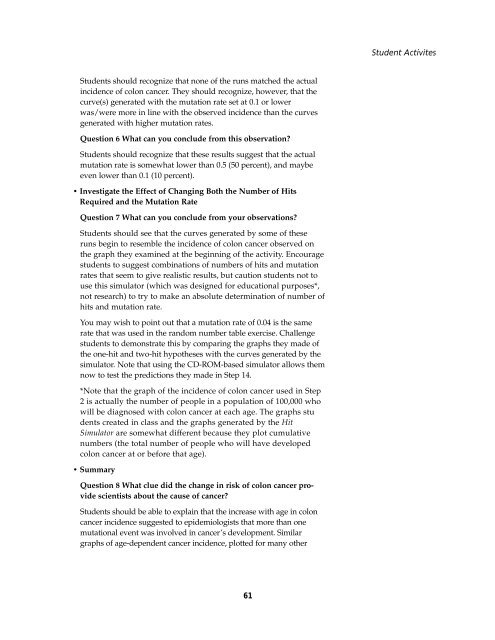Lesson Plan - NIH Office of Science Education
Lesson Plan - NIH Office of Science Education
Lesson Plan - NIH Office of Science Education
- No tags were found...
You also want an ePaper? Increase the reach of your titles
YUMPU automatically turns print PDFs into web optimized ePapers that Google loves.
Student ActivitesStudents should recognize that none <strong>of</strong> the runs matched the actualincidence <strong>of</strong> colon cancer. They should recognize, however, that thecurve(s) generated with the mutation rate set at 0.1 or lowerwas/were more in line with the observed incidence than the curvesgenerated with higher mutation rates.Question 6 What can you conclude from this observation?Students should recognize that these results suggest that the actualmutation rate is somewhat lower than 0.5 (50 percent), and maybeeven lower than 0.1 (10 percent).• Investigate the Effect <strong>of</strong> Changing Both the Number <strong>of</strong> HitsRequired and the Mutation RateQuestion 7 What can you conclude from your observations?Students should see that the curves generated by some <strong>of</strong> theseruns begin to resemble the incidence <strong>of</strong> colon cancer observed onthe graph they examined at the beginning <strong>of</strong> the activity. Encouragestudents to suggest combinations <strong>of</strong> numbers <strong>of</strong> hits and mutationrates that seem to give realistic results, but caution students not touse this simulator (which was designed for educational purposes*,not research) to try to make an absolute determination <strong>of</strong> number <strong>of</strong>hits and mutation rate.You may wish to point out that a mutation rate <strong>of</strong> 0.04 is the samerate that was used in the random number table exercise. Challengestudents to demonstrate this by comparing the graphs they made <strong>of</strong>the one-hit and two-hit hypotheses with the curves generated by thesimulator. Note that using the CD-ROM-based simulator allows themnow to test the predictions they made in Step 14.*Note that the graph <strong>of</strong> the incidence <strong>of</strong> colon cancer used in Step2 is actually the number <strong>of</strong> people in a population <strong>of</strong> 100,000 whowill be diagnosed with colon cancer at each age. The graphs students created in class and the graphs generated by the HitSimulator are somewhat different because they plot cumulativenumbers (the total number <strong>of</strong> people who will have developedcolon cancer at or before that age).• SummaryQuestion 8 What clue did the change in risk <strong>of</strong> colon cancer providescientists about the cause <strong>of</strong> cancer?Students should be able to explain that the increase with age in coloncancer incidence suggested to epidemiologists that more than onemutational event was involved in cancer’s development. Similargraphs <strong>of</strong> age-dependent cancer incidence, plotted for many other61
















